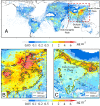Exposure to ambient black carbon derived from a unique inventory and high-resolution model
- PMID: 24469822
- PMCID: PMC3932916
- DOI: 10.1073/pnas.1318763111
Exposure to ambient black carbon derived from a unique inventory and high-resolution model
Abstract
Black carbon (BC) is increasingly recognized as a significant air pollutant with harmful effects on human health, either in its own right or as a carrier of other chemicals. The adverse impact is of particular concern in those developing regions with high emissions and a growing population density. The results of recent studies indicate that BC emissions could be underestimated by a factor of 2-3 and this is particularly true for the hot-spot Asian region. Here we present a unique inventory at 10-km resolution based on a recently published global fuel consumption data product and updated emission factor measurements. The unique inventory is coupled to an Asia-nested (∼50 km) atmospheric model and used to calculate the global population exposure to BC with fully quantified uncertainty. Evaluating the modeled surface BC concentrations against observations reveals great improvement. The bias is reduced from -88% to -35% in Asia when the unique inventory and higher-resolution model replace a previous inventory combined with a coarse-resolution model. The bias can be further reduced to -12% by downscaling to 10 km using emission as a proxy. Our estimated global population-weighted BC exposure concentration constrained by observations is 2.14 μg⋅m(-3); 130% higher than that obtained using less detailed inventories and low-resolution models.
Keywords: air pollution; climate change; emission inventory; model resolution.
Conflict of interest statement
The authors declare no conflict of interest.
Figures





Similar articles
-
Evaluation of MERRA-2 and CAMS reanalysis for black carbon aerosol in China.Environ Pollut. 2024 Feb 15;343:123182. doi: 10.1016/j.envpol.2023.123182. Epub 2023 Dec 18. Environ Pollut. 2024. PMID: 38123119
-
A review on black carbon emissions, worldwide and in China.Chemosphere. 2014 Jul;107:83-93. doi: 10.1016/j.chemosphere.2014.02.052. Epub 2014 Apr 12. Chemosphere. 2014. PMID: 24875874 Review.
-
Elevated Black Carbon Concentrations and Atmospheric Pollution around Singrauli Coal-Fired Thermal Power Plants (India) Using Ground and Satellite Data.Int J Environ Res Public Health. 2018 Nov 5;15(11):2472. doi: 10.3390/ijerph15112472. Int J Environ Res Public Health. 2018. PMID: 30400662 Free PMC article.
-
Dominance of the residential sector in Chinese black carbon emissions as identified from downwind atmospheric observations during the COVID-19 pandemic.Sci Rep. 2021 Dec 16;11(1):23378. doi: 10.1038/s41598-021-02518-2. Sci Rep. 2021. PMID: 34916540 Free PMC article.
-
Highlighting Uncertainty and Recommendations for Improvement of Black Carbon Biomass Fuel-Based Emission Inventories in the Indo-Gangetic Plain Region.Curr Environ Health Rep. 2016 Mar;3(1):73-80. doi: 10.1007/s40572-016-0075-2. Curr Environ Health Rep. 2016. PMID: 26800674 Review.
Cited by
-
Understanding sources of fine particulate matter in China.Philos Trans A Math Phys Eng Sci. 2020 Oct 30;378(2183):20190325. doi: 10.1098/rsta.2019.0325. Epub 2020 Sep 28. Philos Trans A Math Phys Eng Sci. 2020. PMID: 32981431 Free PMC article.
-
Significant contrasts in aerosol acidity between China and the United States.Atmos Chem Phys. 2021;21(10):8341-8356. doi: 10.5194/acp-21-8341-2021. Epub 2021 Jun 1. Atmos Chem Phys. 2021. PMID: 38106813 Free PMC article.
-
Spatial Representativeness Error in the Ground-Level Observation Networks for Black Carbon Radiation Absorption.Geophys Res Lett. 2018 Feb 28;45(4):2106-2114. doi: 10.1002/2017GL076817. Geophys Res Lett. 2018. PMID: 29937603 Free PMC article.
-
Global lung cancer risk from PAH exposure highly depends on emission sources and individual susceptibility.Sci Rep. 2014 Oct 9;4:6561. doi: 10.1038/srep06561. Sci Rep. 2014. PMID: 25297709 Free PMC article.
-
Size-dependent biological effects on vascular endothelial cells induced by different particulate matters.J Huazhong Univ Sci Technolog Med Sci. 2014 Jun;34(3):314-321. doi: 10.1007/s11596-014-1276-2. Epub 2014 Jun 18. J Huazhong Univ Sci Technolog Med Sci. 2014. PMID: 24939292
References
-
- Shindell D, et al. Simultaneously mitigating near-term climate change and improving human health and food security. Science. 2012;335(6065):183–189. - PubMed
-
- Janssen NAH, et al. Health Effects of Black Carbon. Copenhagen: World Health Organization; 2012.
-
- Geng F, et al. Differentiating the associations of black carbon and fine particle with daily mortality in a Chinese city. Environ Res. 2013;120:27–32. - PubMed
-
- Wang X, et al. Associations between fine particle, coarse particle, black carbon and hospital visits in a Chinese city. Sci Total Environ. 2013;458–460:1–6. - PubMed
-
- Koch D, et al. Evaluation of black carbon estimations in global aerosol models. Atmos Chem Phys. 2009;9(22):9001–9026.
Publication types
MeSH terms
Substances
LinkOut - more resources
Full Text Sources
Other Literature Sources

